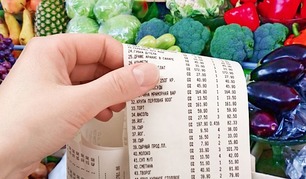|
Have you been in the situation recently where you are shopping in the grocery store and catch yourself gasping at the food prices and think “$7.99 for a head of cauliflower, $13.00 for two chicken breasts?!” Seeing these prices can make a person who is trying to eat a healthy, wholesome diet feel discouraged and frustrated. As per the University of Guelph’s Annual Food Price report, the cost of food rose 4.1 % in 2015 when it was expected to rise by only 3.0%. This rise in food cost was significantly above the rate of inflation. There are many reasons for this; the dollar losing value this past year, our high dependency on imported produce, global draughts, and living in a northern climate. All of these factors make for buying affordable, healthy food challenging. So is it possible to stick within a budget while still eating a healthy diet? Let’s explore. Instead of purchasing expensive produce such as asparagus or cauliflower, opt for items such as broccoli, cabbage, and brussel sprouts. Be flexible with your recipes and substitute inexpensive vegetables where possible. Swap your baby carrots with large bagged carrots (you can find a deal for $1.99 per 5lbs for those orange suckers!). You can also get a bag of 3lb onions for as little as $1.69, which gives you about 8 onions – more than a weeks worth. As for fruit, apples, grapefruits, oranges, and bananas are relatively inexpensive year round and remain your best value. Frozen vegetables and fruit are also a suitable option. Frozen fruit and vegetables are picked at their peak ripeness and flash frozen so nutrient damage is minimal. Taking a cost comparison, you can get a bag of 600g of fruit for under $5.00 on sale. At best, fresh berries are on for $2.50 per 200g. No deal there. If you choose to use canned, make sure you run your veggies under water to rinse out the excess sodium that is used for preserving. As for nuts, almond and hazelnut prices are at an all time high. Replace these with alternatives such as peanuts, sunflower and pumpkin seeds to reduce the cost while maintaining similar nutritional value. You can roast them, add them to your oatmeal, use them in homemade granola bars, or mix into your yogurt. They have that same crunchy nutty flavour but at a much lower price. Another way to save on cost is to reduce your consumption of meat. 2016 is the International Year of Pulses. Pulses are part of the legume family and refer to a family of dried items such as beans, lentil and chickpeas. Pulses are a great source of protein and fibre, are low in fat, and have a low carbon footprint. An easy way to incorporate pulses are replacing half of your meat with them, or opting for more vegetarian meals throughout the week.  Another great way to reduce cost is to utilize all of your food and minimize waste. Keep the stems of your broccoli and the ends of your celery and make homemade stock. Plan your meals ahead of time and make a list. It sounds old fashioned, but making a list minimizes the “oh we could use that” mindless shopping while strolling the aisles. This way you know what you are getting and may be less likely to stray from that list. But by far, the biggest way to save money is to reduce your food waste. If your produce begins to look wilted or unappetizing, throw it in a stir-fry or add it to a stew. And best before dates are more of an indicator of quality and not necessarily safety. Be grateful for our lush availability of international foods and be kind to your wallet. Healthy eating in the midst of rising food prices isn’t easy, but is possible. Emilie Trottier, RD, Sports Dietitian Registered Dietitian and Sports Dietitian at Evolved Sport and Nutrition [email protected]
2 Comments
29/4/2020 03:56:54 am
It seems like everything that we see in supermarkets have high price already. it is something that we cannot avoid anymore. That's why more and more people are trying to find an extra job to sustain their needs. To live nowadays is a hard thing to do actually, and I feel bad that we have to suffer this way. but there is nothing that we can do but we need to adjust because that is the economic state that we need to deal with right now. I just hope that all people could adjust to this.
Reply
Leave a Reply. |
Categories
All
Archives
November 2021
|
- Home/ News
- About
- Services/ Store
- Media
-
Learning Center
- ESN Athletic and Healthy Lifestyle Learning Center >
-
Professional Learning Center
>
-
The ESN Sports Nutrition Certificate
>
- ESN Learning Center - Sports Nutrition Certificate Level 1 >
- ESN Learning Center Sports Nutrition Certificate Level 2 >
-
ESN Learning Center - Sports Nutrition Certificate Level 3
>
- Module 1 - Periodization for the Athlete
- Module 2 - Nutrition Strategies to Optimize Recovery
- Module 3 - Sports Nutrition for Children and Young Athletes
- Module 4 - Sports Nutrition for the Aging Athlete
- Module 5 - Nutritional Strategies for Injury Prevention and Concussions
- Module 6 - Nutritional Strategies for the Travelling Athlete
- Module 7 - Tournament Nutrition Strategies
-
The ESN Sports Nutrition Certificate
>
- Contact
Proudly powered by Weebly



 RSS Feed
RSS Feed